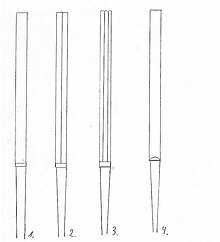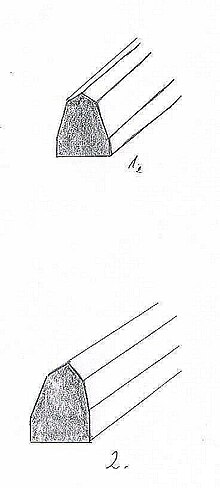Mune (sword)
Mune ( Japanese 棟 , German " roof ridge ") is the name given to the back of the blade of Japanese blades.
description
There are different forms of mune, which are called differently. The categorizations are:
- Kaku-mune ( 角 棟 , "angular mune") or Hira-mune ( 平 棟 , "flat mune"): Describes a blade back that is flat over its entire length. This type of Mune can only be found on very old blades (see picture 1, no. 1).
- Iori-mune ( 庵 棟 , "Klause / Einsiedelei-Mune") or Gyō-no-mune ( 行 の 棟 , " Ascetic Mune"): The mune is designed here in an A-shape. This form became very popular after the Kotō ( 古 刀 , "old swords") - a collective term for swords from the Heian period (from 794) to the Keichō era (from 1596). With the blades of the Yamato tradition , associated swordsmith schools or those of the swordsmith master Hankei, one often finds a steep Oroshi ( 下 ろ し , rise in the mune). The blades of the Bizen tradition often have a gentle oroshi (see picture 1. No. 2).
- Mitsu-mune ( 三 つ 棟 , "three-piece mune") or Shin-no-mune ( 真 の 棟 , "true mune, mune of truth"). This type of Mune has three surfaces, comparable to a house roof with a flattened ridge . They are often found on blades of the Sōshū tradition and associated schools, as well as the Tantō blades of the Yamashiro tradition . Early blades of the Sōshū tradition have a wide, upper surface and a steep oroshi . However, blades from the associated Sue Sōshū school have a narrow, upper surface. They are often found on Shinto blades ( „ 刀 ," new swords ", swords from the Keicho era) on the blades of master swordsmith Umetada Myoju from the Horikawa school and master swordsmith Echizen Yasutsugu (around 1600, Yasutsugu school), both of which belong to the Sōshū tradition (see picture 1. No. 3).
- Maru-mune ( 丸 棟 , "round mune") or Sō-no-mune ( 草 の 棟 , "grass mune"): Describes a rare type of mune that has a rounded surface. These can be found on blades of the Ko-aoe, Saikaido and Hokurikudo schools (see Figure 1. No. 4).
A "gentle" oroshi , d. H. the back of the blade has slightly flattened side surfaces, is shown on picture 2, no. 1 and a "steep" oroshi with steeper, flattened side surfaces on picture 2, no. 2.
Individual evidence
- ↑ a b Kōkan Nagayama: The Connoisseur's Book of Japanese Swords. Kodansha International, Tokyo 1998, ISBN 4-7700-2071-6 , p. 57, note: The source translates Iori as “roof ridge”, which is actually called Mune in Japanese . Iori-mune actually means "hermitage mune" or "hermitage roof".
- ↑ Kōkan Nagayama: The Connoisseur's Book of Japanese Swords. Kodansha International, Tokyo 1998, ISBN 4-7700-2071-6 , p. 226.
- ↑ Kōkan Nagayama: The Connoisseur's Book of Japanese Swords. Kodansha International, Tokyo 1998, ISBN 4-7700-2071-6 , p. 241.
literature
- Nobuo Ogasawara: Japanese swords . 12th edition. Hoikusha, Osaka 1993, ISBN 4-586-54022-2 ( Color Books 22).
- Kanzan Satō: The Japanese Sword. Translated and adapted by Joe Earle. Kodansha International, Tokyo et al. 1983, ISBN 0-87011-562-6 ( Japanese Arts Library 12).
- John M. Yumoto: The Samurai Sword. A handbook . Tuttle Publishing, Rutland VT et al. 1988, ISBN 0-8048-0509-1 .
Web links
Commons : Japanese Swords - Collection of Images, Videos and Audio Files

